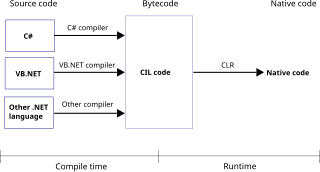VBScript is an Active Scripting language developed by Microsoft that is modeled on Visual Basic. It allows Microsoft Windows system administrators to generate powerful tools for managing computers with error handling, subroutines, and other advanced programming constructs. It can give the user complete control over many aspects of their computing environment.
The Visual Component Library (VCL) is a visual component-based object-oriented framework for developing the user interface of Microsoft Windows applications. It is written in Object Pascal.
Windows Management Instrumentation (WMI) consists of a set of extensions to the Windows Driver Model that provides an operating system interface through which instrumented components provide information and notification. WMI is Microsoft's implementation of the Web-Based Enterprise Management (WBEM) and Common Information Model (CIM) standards from the Distributed Management Task Force (DMTF).
JScript .NET is a .NET programming language developed by Microsoft.
IronPython is an implementation of the Python programming language targeting the .NET Framework and Mono. Jim Hugunin created the project and actively contributed to it up until Version 1.0 which was released on September 5, 2006. Thereafter, it was maintained by a small team at Microsoft until the 2.7 Beta 1 release; Microsoft abandoned IronPython in late 2010, after which Hugunin left to work at Google. IronPython 2.0 was released on December 10, 2008. The project is currently maintained by a group of volunteers at GitHub. It is free and open-source software, and can be implemented with Python Tools for Visual Studio, which is a free and open-source extension for Microsoft's Visual Studio IDE.
Managed Extensions for C++ or Managed C++ is a now-deprecated set of language extensions for C++, including grammatical and syntactic extensions, keywords and attributes, to bring the C++ syntax and language to the .NET Framework. These extensions were created by Microsoft to allow C++ code to be targeted to the Common Language Runtime (CLR) in the form of managed code, as well as continue to interoperate with native code.
Metadata, in the Common Language Infrastructure (CLI), refers to certain data structures embedded within the Common Intermediate Language (CIL) code that describes the high-level structure of the code. Metadata describes all classes and class members that are defined in the assembly, and the classes and class members that the current assembly will call from another assembly. The metadata for a method contains the complete description of the method, including the class, the return type and all of the method parameters.
Code Access Security (CAS), in the Microsoft .NET framework, is Microsoft's solution to prevent untrusted code from performing privileged actions. When the CLR loads an assembly it will obtain evidence for the assembly and use this to identify the code group that the assembly belongs to. A code group contains a permission set. Code that performs a privileged action will perform a code access demand which will cause the CLR to walk up the call stack and examine the permission set granted to the assembly of each method in the call stack. The code groups and permission sets are determined by the administrator of the machine who defines the security policy.

C# is a general-purpose, multi-paradigm programming language encompassing strong typing, lexically scoped, imperative, declarative, functional, generic, object-oriented (class-based), and component-oriented programming disciplines. It was developed around 2000 by Microsoft within its .NET initiative and later approved as a standard by Ecma (ECMA-334) and ISO. C# is one of the programming languages designed for the Common Language Infrastructure.
Platform Invocation Services, commonly referred to as P/Invoke, is a feature of Common Language Infrastructure implementations, like Microsoft's Common Language Runtime, that enables managed code to call native code.
In Microsoft Windows applications programming, OLE Automation is an inter-process communication mechanism created by Microsoft. It is based on a subset of Component Object Model (COM) that was intended for use by scripting languages – originally Visual Basic – but now is used by several languages on Windows. All automation objects are required to implement the IDispatch interface. It provides an infrastructure whereby applications called automation controllers can access and manipulate shared automation objects that are exported by other applications. It supersedes Dynamic Data Exchange (DDE), an older mechanism for applications to control one another. As with DDE, in OLE Automation the automation controller is the "client" and the application exporting the automation objects is the "server".
The Microsoft Windows operating system supports a form of shared libraries known as "dynamic-link libraries", which are code libraries that can be used by multiple processes while only one copy is loaded into memory. This article provides an overview of the core libraries that are included with every modern Windows installation, on top of which most Windows applications are built.
Blittable types are data types in the Microsoft .NET framework that have an identical presentation in memory for both managed and unmanaged code. Understanding the difference between blittable and non-blittable types can aid in using COM Interop or P/Invoke, two techniques for interoperability in .NET applications.
CS-Script is a CLR based scripting system which uses ECMA-compliant C# as a programming language. CS-Script currently targets Microsoft implementation of CLR and with full support for Mono.
Windows Runtime (WinRT) is a platform-agnostic application architecture first introduced in Windows 8 and Windows Server 2012 in 2012. WinRT supports development in C++/WinRT, C++/CX, JavaScript-TypeScript, and the managed code languages C# and Visual Basic .NET (VB.NET). WinRT applications natively support both the x86 and ARM processors, and may run inside a sandboxed environment to allow greater security and stability. WinRT components are designed with interoperability between multiple languages and APIs in mind, including native, managed and scripting languages.

Mono is a free and open-source project to create an Ecma standard-compliant .NET Framework-compatible software framework, including a C# compiler and a Common Language Runtime. Originally by Ximian, it was later acquired by Novell, and is now being led by Xamarin, a subsidiary of Microsoft and the .NET Foundation. The stated purpose of Mono is not only to be able to run Microsoft .NET applications cross-platform, but also to bring better development tools to Linux developers. Mono can be run on many software systems including Android, most Linux distributions, BSD, macOS, Windows, Solaris, and even some game consoles such as PlayStation 3, Wii, and Xbox 360.



